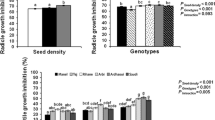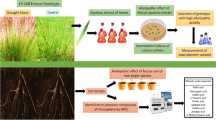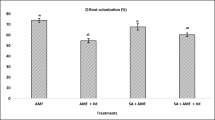Abstract
Hydroxamic acids (Hx) produced by some cereal crops have been associated with allelopathy. However, the release of Hx to the soil by the producing plant-an essential condition for a compound to be involved in allelopathy-has not been shown. GC and HPLC analysis of roots and root exudates of wheat (Triticum aestivum L.) and rye (Secale cereale L.) cultivars, with high Hx levels in their leaves, demonstrated the presence of these compounds in the roots of all cultivars analyzed and in root exudates of rye. Moreover, bioassays employing root exudates collected from wheat and rye seedlings demonstrated that only rye exudates inhibited root growth of wild oats,Avena fatua L., a weed whose root growth is inhibited by Hx. These results suggest that rye could potentially interfere with the growth ofAvena fatua in nature and that this interference could be due to the release of Hx to the soil by way of roots.
Similar content being viewed by others
References
Abdul-Wahab, A.S., andRice, E.L. 1967. Plant inhibition by Johnson grass and its possible significance in old-field succession.Bull. Torrey Bot. Club 94:486–493.
Argandoña, V.H., Zuñiga, G.E., andCorcuera, L.J. 1987. Distribution of gramine and hydroxamic acids in barley and wheat leaves.Phytochemistry 26:1917–1918.
Barnes, J.P., andPutnam, A.R. 1987. Role of benzoxazinones in allelopathy by rye (Secale cereale L.).J. Chem. Ecol. 13:889–905.
Barnes, J.P., Putnam, A.R., andBurke, A.B. 1986. Allelopathic activity of rye (Secale cereale L.), pp. 276–286,in The Science of Allelopathy. A.R. Putnam and C.S. Tang (eds.). John Wiley & Sons, New York.
Barnes, J.P., Putnam, A.R., Burke, A.B., andAasen, J.A. 1987. Isolation and characterization of allelochemicals in rye herbage.Phytochemistry 26:1385–1390.
Bell, A.R., andNalewaja, J.D. 1968. Competition of wild oat in wheat and barley.Weed Sci. 16:505–508.
Cudvey, D.W., Jordan, L.S., Holt, J.S., andReints, J.S. 1989. Competitive interactions of wheat (Triticum aestivum) and wild oats (Avena fatua) grown at different densities.Weed Sci. 37:538–543.
Jernow, J.L., andRosen, P. 1975. 2H-1,4 Benzoxazin-3(4H)-ones. U.S. Patent 3,862,180.
Nair, E.M., Whitenack, C.J., andPutnam, A.R. 1990. 2,2'-Oxo-1,1'-azobenzene a microbially transformed allelochemical from 2,3-benzoxazolinone.J. Chem. Ecol. 16:353–364.
Niemeyer, H.M. 1988. Hydroxamic acids (4-hydroxy-1,4-benzoxazin-3-ones), defense chemicals in the Gramineae.Phytochemistry 27:3349–3358.
Niemeyer, H.M., Pesel, E., Franke, S., andFrancke, W. 1989. Ingestion of the benzoxazinone DIMBOA from wheat plants by aphids.Phytochemistry 28:2307–2310.
Nye, P.H., andTinker, P.B. 1977. Solute movement on the soil root system. Studies in Ecology, Vol. 4. Blackwell, Oxford, pp. 342–355.
Pérez, F.J. 1990. Allelopathic effect of hydroxamic acids from cereals onA. sativa andA. fatua.Phytochemistry 29:773–776.
Queirolo, C.B., Andreo, C.S., Niemeyer, H.M., andCorcuera, L.J. 1983. Inhibition of ATPase from chloroplast by hydroxamic acid from the Gramineae.Phytochemistry 22:2455–2458.
Rovira, A.D. 1969. Plant root exudates.Bot. Rev. 35:35–59.
Rice, E.L. 1984. Allelopathy, 2nd ed. Academic Press, Orlando.
Tang, C.S., andYoung, C.C. 1982. Collection and identification of allelopathic compounds from the undisturbed root system of Bigakta Limpograss (Hemarthria altissima).Plant Physiol. 69:155–160.
Author information
Authors and Affiliations
Rights and permissions
About this article
Cite this article
Pérez, F.J., Ormenoñuñez, J. Difference in hydroxamic acid content in roots and root exudates of wheat (Triticum aestivum L.) and rye (Secale cereale L.): Possible role in allelopathy. J Chem Ecol 17, 1037–1043 (1991). https://doi.org/10.1007/BF01402932
Received:
Accepted:
Issue Date:
DOI: https://doi.org/10.1007/BF01402932




